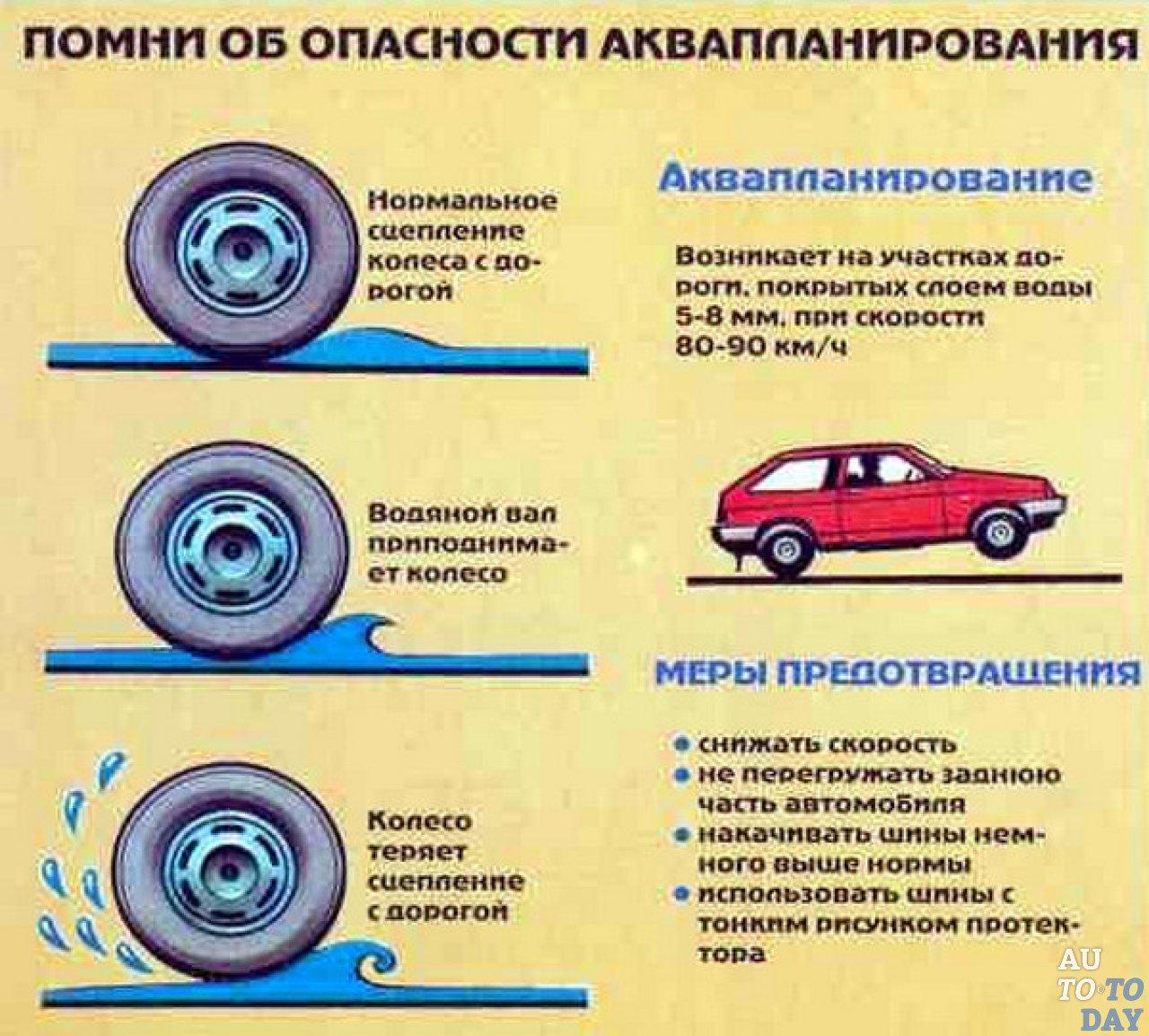
Hydroplaning - when nature shows its power
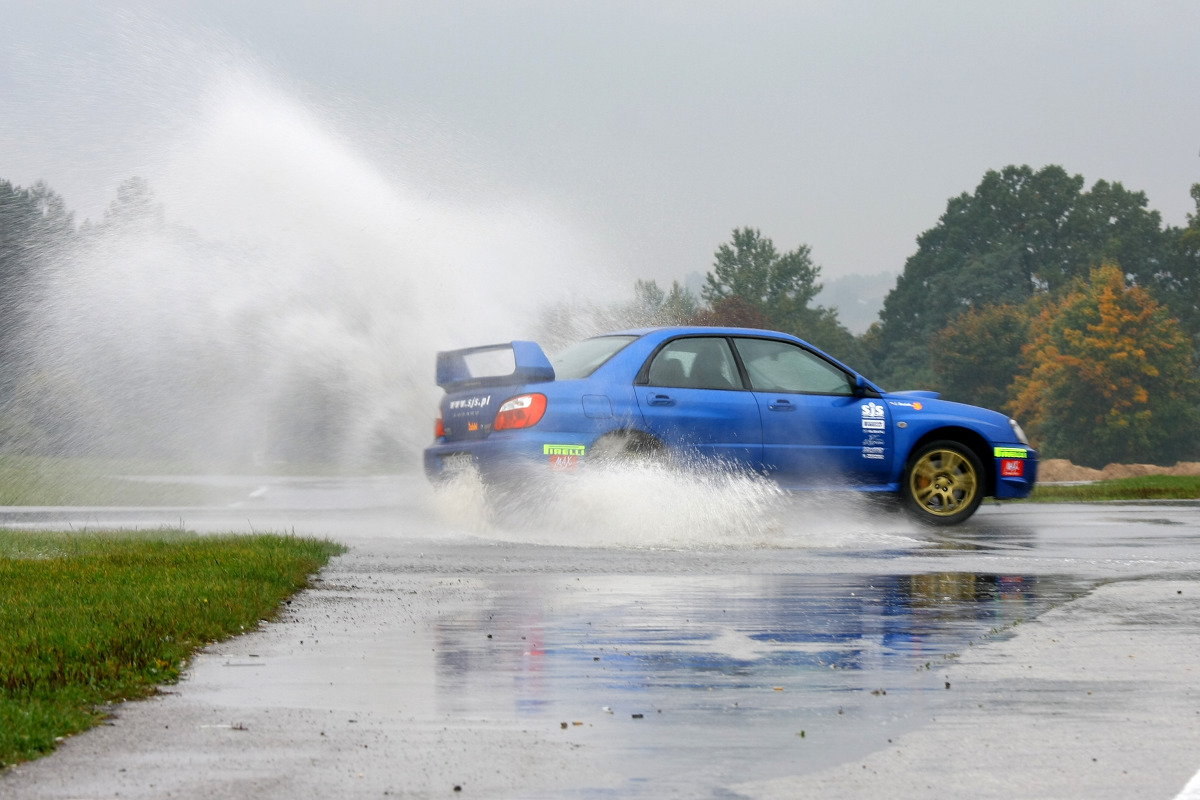 Although this is only the beginning of the year, and the snowy winter has not yet allowed us to completely forget about ourselves, with the first thaws it is time to look at a phenomenon that is very important from the point of view of our security. on the road. Before, however, the potholes in the roadway, which are now forming like mushrooms after rain, will be filled to the brim with melting snow. Before the rivers formed as a result of spring rains flow into the ruts known as Polish roads, it is worth taking the time to understand what the phenomenon of hydroplaning is.
Although this is only the beginning of the year, and the snowy winter has not yet allowed us to completely forget about ourselves, with the first thaws it is time to look at a phenomenon that is very important from the point of view of our security. on the road. Before, however, the potholes in the roadway, which are now forming like mushrooms after rain, will be filled to the brim with melting snow. Before the rivers formed as a result of spring rains flow into the ruts known as Polish roads, it is worth taking the time to understand what the phenomenon of hydroplaning is.
Supporters of the purity of our language will surely like the word aquaplaning or pillow 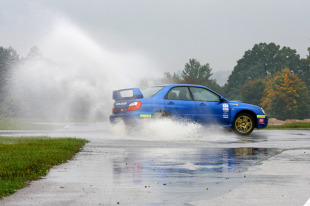 water. On the other hand, those who love linguistic travel will also hear the word "hydroplaning". All these terms are interchangeable. Often, according to various opinions of experts, police officers and road workers, this topic appears in the context of potential or real problems with the car's grip on the road. What is it really and how to deal with this undesirable and very dangerous phenomenon? When does it happen? Or maybe we ourselves are its culprits? Let's see.
water. On the other hand, those who love linguistic travel will also hear the word "hydroplaning". All these terms are interchangeable. Often, according to various opinions of experts, police officers and road workers, this topic appears in the context of potential or real problems with the car's grip on the road. What is it really and how to deal with this undesirable and very dangerous phenomenon? When does it happen? Or maybe we ourselves are its culprits? Let's see.
First, let's start with a definition. In simple terms, hydroplaning in the automotive industry is the phenomenon of loss of traction while driving due to the formation of a layer of water between the asphalt and the tire. When a tire (for various reasons) is unable to remove enough water that accumulates in front of it in the form of a wave, a so-called water wedge occurs. With all the power of physics, it will be sandwiched between the tire and the road, drastically reducing the car's handling and ability to brake effectively! On the driver's side, hydroplaning feels like driving on ice. This is not an exaggeration! Can I also meet it in everyday driving? Oh yeah! And more often than we all think. While working at Subaru Driving School, I very often had to observe the surprise of participants starting the 1st degree training when, in the theoretical part, supported by a training video, an example of the behavior of a car in a specially prepared gutter was given. was presented. By the way, what the Germans or Austrians have a training module built for educational purposes, then Poland has everyday routines. What was on it? Well, I drove into an artificially created, long and relatively deep puddle (only 80 cm!). Speed 100 km/h, car without electronic driver assistance systems. The shot begins with a wide shot where the car can be seen dying in huge plumes of water ejected from under the wheels. The real scene begins. The car's clock is shown, which clearly shows how, despite the added gas, the speed remains almost unchanged, and the revolutions increase significantly each time the right pedal is pressed. This feeling is almost XNUMX% in line with ours 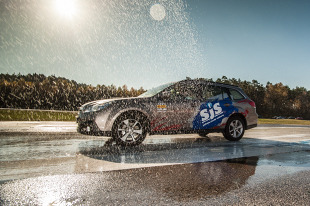 the clutch has stopped working. This is the first encounter with hydroplaning. What's so dangerous about it? Let's watch the movie next. What was the aforementioned surprise of the participants who observed this simulated event “from the inside”. The biggest surprise is always the moment when, for training purposes, the instructor starts turning the steering wheel while driving straight ahead. To reinforce the message, he does so to the extreme positions of the steering wheel, from right to left and back. What happens to the car then? Nothing, absolutely no reaction from the machine! The wheels turn again and again, but the car slides in a straight line without interference. Driving the following meters, some drivers may assume that this is just an opportunity to have fun, scaring the passenger. Unfortunately, physicists don't know how to joke. Turning the steering wheel in this situation can have serious consequences. The instructor deliberately ends the ride (leaves a puddle) on twisted wheels. The effect? In the blink of an eye, he finds himself in the oncoming lane, and wet tires, unable to provide full traction, cause the rear axle to skid! Comment is redundant.
the clutch has stopped working. This is the first encounter with hydroplaning. What's so dangerous about it? Let's watch the movie next. What was the aforementioned surprise of the participants who observed this simulated event “from the inside”. The biggest surprise is always the moment when, for training purposes, the instructor starts turning the steering wheel while driving straight ahead. To reinforce the message, he does so to the extreme positions of the steering wheel, from right to left and back. What happens to the car then? Nothing, absolutely no reaction from the machine! The wheels turn again and again, but the car slides in a straight line without interference. Driving the following meters, some drivers may assume that this is just an opportunity to have fun, scaring the passenger. Unfortunately, physicists don't know how to joke. Turning the steering wheel in this situation can have serious consequences. The instructor deliberately ends the ride (leaves a puddle) on twisted wheels. The effect? In the blink of an eye, he finds himself in the oncoming lane, and wet tires, unable to provide full traction, cause the rear axle to skid! Comment is redundant.
Is it possible to fight hydroplaning? Yes, but not literally. Our task as a driver is prevention by minimizing the risk of its occurrence. The risk of occurrence increases with the speed at which we move, the thickness of the water film on the pavement, or, finally, the worse condition of our tires (shallower tread depth or pollution). Therefore, we increase our safety accordingly, while maintaining moderation in adjusting the speed to road conditions and the need to get home as soon as possible. When driving in the rain, we avoid places where water accumulates and flows. In the same way, in the case of a dry road, when we see puddles, we try to avoid them, and if this is not possible, then we slow down and try to overcome them with straight wheels, avoiding sharp maneuvers with both pedals and steering wheel. Why? First, we eliminate the risk of this phenomenon by moving more slowly. Secondly, if you go straight through it, even if it happens, the skid will be in the direction of travel (less dangerous). Thirdly, driving in a curve, as we have repeatedly mentioned on the site "Safe Driving", leads to the fact that a lateral force acts on the tires. They begin to work, curled up under the rim. The higher the profile of our tire and the greater the force (higher cornering speed or tighter wheels), the more the tire deforms. What does this mean for us? Good,  it is very likely that part of the grooves designed to drain water from under the wheels will “close” almost completely. In this case, an attempt to overcome a puddle in a turn will end with a spectacular skid of the front axle (understeer), which means a very dangerous traffic situation. We return to the so often brought up topic of correctly observing the road, far enough so that we have time to prepare for the maneuver. Let's give ourselves and other road users a chance to be safe on the road.
it is very likely that part of the grooves designed to drain water from under the wheels will “close” almost completely. In this case, an attempt to overcome a puddle in a turn will end with a spectacular skid of the front axle (understeer), which means a very dangerous traffic situation. We return to the so often brought up topic of correctly observing the road, far enough so that we have time to prepare for the maneuver. Let's give ourselves and other road users a chance to be safe on the road.
What if the puddle seems endless, like in ruts? If we have to face them, of course, if possible, we go along the “tops of the asphalt”, trying not to touch the gutters filled with water with the wheels. If we have already entered the track, we maintain a constant speed and, controlling the distance to the vehicle in front, in no case try to move off it. If the situation forces us to do so, we maneuver with a smooth driver movement (small angle), waiting for the tire to gain some traction. In this way, we will avoid the risk of dangerous destabilization of the car (as I described in the tutorial video) as a result of a sudden change in grip on wheels that are too tight. This could cause a sharp, aggressive jerk of the entire car and, as a result, a sudden skid, fall off the road and, in extreme cases, even a rollover.
Throughout this physical game, we keep repeating statements about tires. They are, of course, crucial. Good tires from recognized manufacturers can greatly improve our safety. However, we will not assure that they will completely protect us from hydroplaning. No matter which tire we choose, it will always appear, the difference will be at what speed it will appear. Leading manufacturers invest huge sums  resources for research and development, offering ever more effective solutions in this area. However, some patterns do not change. The first is the relationship between tire width and hydroplaning tendency. The wider the tires, the sooner (at slower speeds) we will lose traction. As a rule, narrower tires are less susceptible to this phenomenon due to the need to drain less water. I remember the surprise, even the anger, of two participants in a training I once held in Tor Kielce. They both arrived in cars worth more than PLN 300.000, equipped with countless driver assistance systems, excellent UHP (Ultra High Performance) tires and convincing their owners of superiority on the road. However, reality is cruel. Physics doesn't care how much we spent on the car. During practical training on emergency braking, as they later admitted, they experienced a real shock. The training was to stop the car as quickly as possible on a road covered in water. The cars of these very nice gentlemen were at a speed of 80 km / h to stop at a distance of about 20 meters more than that of a filigree student from the same group who was driving a normal car. The difference in the weight of the car was insignificant, in the width of the tires it was huge! It is worth knowing about this dependency. Before deciding to overtake, because this “protracted” mercilessly lagging behind car is much weaker than me.
resources for research and development, offering ever more effective solutions in this area. However, some patterns do not change. The first is the relationship between tire width and hydroplaning tendency. The wider the tires, the sooner (at slower speeds) we will lose traction. As a rule, narrower tires are less susceptible to this phenomenon due to the need to drain less water. I remember the surprise, even the anger, of two participants in a training I once held in Tor Kielce. They both arrived in cars worth more than PLN 300.000, equipped with countless driver assistance systems, excellent UHP (Ultra High Performance) tires and convincing their owners of superiority on the road. However, reality is cruel. Physics doesn't care how much we spent on the car. During practical training on emergency braking, as they later admitted, they experienced a real shock. The training was to stop the car as quickly as possible on a road covered in water. The cars of these very nice gentlemen were at a speed of 80 km / h to stop at a distance of about 20 meters more than that of a filigree student from the same group who was driving a normal car. The difference in the weight of the car was insignificant, in the width of the tires it was huge! It is worth knowing about this dependency. Before deciding to overtake, because this “protracted” mercilessly lagging behind car is much weaker than me.
Okay, we already have good tires. We know what hydroplaning is and how it occurs. Adjusting to everyday driving 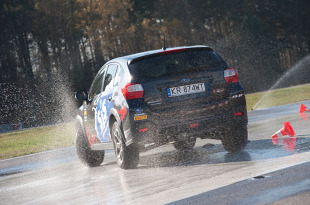 speed to the conditions on the road, we have learned to observe the road and choose the route wisely, minimizing the risk of this phenomenon. Is that all we need to know to travel safely without unpleasant surprises? To do this, it is necessary to mention one more very important issue. About what is underestimated by the vast majority of drivers. Let's answer the question whether we belong to this group. I'm talking about the systematic care of the correct tire pressure. Well, the “guest” is smart! After all, when I change tires for spring and autumn, vulcanizers pump our wheels. And in general, nothing of the kind will happen if there are disagreements. Unfortunately, such a statement lingers in the minds of drivers. It has many aspects, and today I may be able to convince the doubters through the prism of the risk of aquaplaning. In order not to be accused of a biased story, I will use the results of an independent study conducted by the German ADAC, an institution with an undeniable position in the field of road safety. The visualization next to it perfectly shows how the loss of pressure dramatically increases the risk of hydroplaning. We see that under the same conditions, at the same speed, using the same vehicle and tire, a pressure drop from 2 to 1,5 bar leads to a decrease in the tire's grip surface on asphalt by as much as 50%! As an instructor, I love to observe what is happening around me. I look at who is driving, what and in what condition their tires are, how they hold the steering wheel - this is such a professional bias. When I look at wheels, I most often see unnaturally deformed, under-inflated tires. I recommend checking the pressure! Compressors are now available for free at almost every major station. The only question is whether the public pressure gauge is working. If I managed to convince some of you that this is worth doing, then I recommend buying a small electronic pressure gauge that will always fit in the car and give us confidence in the measurement. Another gadget for a guy? Maybe it is, or maybe just a simple tool in the world that affects our security. The only question is, will we find the time and desire to take advantage of this when we are in a hurry? Good way.
speed to the conditions on the road, we have learned to observe the road and choose the route wisely, minimizing the risk of this phenomenon. Is that all we need to know to travel safely without unpleasant surprises? To do this, it is necessary to mention one more very important issue. About what is underestimated by the vast majority of drivers. Let's answer the question whether we belong to this group. I'm talking about the systematic care of the correct tire pressure. Well, the “guest” is smart! After all, when I change tires for spring and autumn, vulcanizers pump our wheels. And in general, nothing of the kind will happen if there are disagreements. Unfortunately, such a statement lingers in the minds of drivers. It has many aspects, and today I may be able to convince the doubters through the prism of the risk of aquaplaning. In order not to be accused of a biased story, I will use the results of an independent study conducted by the German ADAC, an institution with an undeniable position in the field of road safety. The visualization next to it perfectly shows how the loss of pressure dramatically increases the risk of hydroplaning. We see that under the same conditions, at the same speed, using the same vehicle and tire, a pressure drop from 2 to 1,5 bar leads to a decrease in the tire's grip surface on asphalt by as much as 50%! As an instructor, I love to observe what is happening around me. I look at who is driving, what and in what condition their tires are, how they hold the steering wheel - this is such a professional bias. When I look at wheels, I most often see unnaturally deformed, under-inflated tires. I recommend checking the pressure! Compressors are now available for free at almost every major station. The only question is whether the public pressure gauge is working. If I managed to convince some of you that this is worth doing, then I recommend buying a small electronic pressure gauge that will always fit in the car and give us confidence in the measurement. Another gadget for a guy? Maybe it is, or maybe just a simple tool in the world that affects our security. The only question is, will we find the time and desire to take advantage of this when we are in a hurry? Good way.

